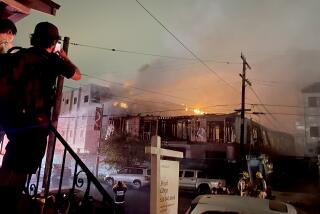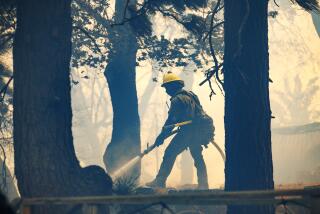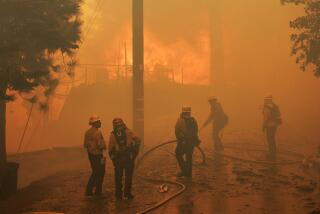Sifting Through the Ashes : Community: In Kinneloa Canyon, residents greet the sight of a fire-ravaged neighborhood with astonishment and anguish.
PASADENA â Notes from Kinneloa Canyon on the day after:
Norris Pratt, vice president for sales at a food company, was on his way home from New York when fire struck his neighborhood Wednesday.
âI was in ignorant bliss, coming in on an airplane,â he recalled Thursday.
But his wife, Betty, had left a message for him at the United Airlines Terminal at Los Angeles International Airport, telling him that the unincorporated area near Pasadena was in flames.
As he reached his neighborhood, Pratt, a Navy veteran, was suddenly transported to another era.
âIt was so reminiscent of Vietnam,â he said. âAll the burning and the smell, the taste of smoke, the noise and confusion--your first reaction is to aid those who were less fortunate than you.â
The Pratt home on Glen Springs Road was spared major damage. The end of one beam on the outside of the house burned almost to the wall. The fire had either gone out or was extinguished by firefighters. But more than half of his neighborsâ houses were destroyed.
Pratt, the secretary of the Kinneloa Estates Assn., summed up the toll.
âYesterday we had 34 members. Today we have 16.â
*
John Lorant was standing in front of his two-story home on Kinneloa Canyon Road on Thursday, scanning the hillside above and reflecting on a recent decision he had made.
âLast month, I spent thousands of dollars to clean all of that (underbrush) out and put in an irrigation system,â he said.
The fire apparently moved halfway down the hill, stopping where Lorantâs hillside cleanup began. The trees along the bottom 50 feet of the hill were clear of underbrush and untouched by fire.
And Lorantâs house was untouched as well.
*
Corrine Ray isnât the type to panic. A registered nurse who has worked in emergency rooms, she is the education director for the Los Angeles Regional Poison Information Center.
âIâve been through disaster drills in hospitals, but you donât do that in your own home,â she said Thursday, as family members began to sweep up. The home sustained a glancing blow from Wednesdayâs firestorm along Kinneloa Canyon Road. A carport was seared and the house was filled with soot.
By the time she and her husband, John, realized that flames were heading their way, they had about five minutes to get out.
âYou stand there and youâre absolutely numb,â she recalled. âI was in my nightgown and all I could think of was, âIâd better throw some clothes on.â â
The couple grabbed their pets--two dogs and a cat--and headed down the hill in separate cars. They left important papers, valuables, family mementos, clothing--just about everything.
They were lucky. The heat along the path 20 feet behind the house was so intense that it turned a 15-foot fiberglass sailboat into a puddle of plastic. A metal shed, which imploded from the heat, resembled a flattened tin can.
âThe lesson I learned is that you need a plan,â Ray said. âYou need to know how youâre going to get out. You need to practice getting yourself and your pets out. Youâd better be prepared.â
*
Floyd Loupot, 71, stood in front of his house--actually, just a brick chimney and an expanse of ash--and greeted neighbors with big smiles and hugs. The businessman, who owns a nursing home and a hearing aid firm, was pretty chipper for someone who had lost his home of 30 years, someone said.
âWhat can you do about it?â said Loupot, who lives alone. âThe only time I get a little emotional is when people come and tell me, âFloyd, we want you to come and move in with us.â That kind of gets to me.â
Most of his neighbors on Kinclair Road were not as philosophical. Some of them surveyed the area, holding their hands over their mouths.
âIt looks like a bomb dropped,â said one woman.
*
People stood in front of their homes--or their former homes--and considered the irony of it all. There was no accounting for the hits and misses.
Ed and Vicki Wadeâs house, across the street from Loupot, was unscathed.
âLook at it,â Vicki Wade said, pointing across the street. âWeâve still got green grass.â
For the unlucky ones, there was often a blank, uncomprehending look.
âIt hasnât really hit yet,â Ron Mosier, whose house also was spared, said of those who were less fortunate. âPeople are being pretty objective, like theyâre looking at someone elseâs home.â
Emergency Numbers
American Red Cross: (818) 799-0841
For help finding finding food, shelter or medical supplies. Donations and volunteers are needed. The Red Cross service center is at the Westminster Presbyterian Church, 1757 N. Lake Ave., Pasadena, and will be open from 9:30 a.m. to 6:30 p.m.
Salvation Army Disaster Services Office: (800) 725-9005
Call this number for assistance or to donate money and supplies to fire victims.
Federal Emergency Management Agency: (800) 462-9029 or (800) 462-7585 for the hearing-impaired
For information on loans for small businesses, disaster housing assistance and individual family grant programs.
Rep. David Drierâs office: (818) 339-9078 or (909) 592-2837
112 N. 2nd Ave., Covina, Calif. 91723
Staff at the congressmanâs office will help disaster victims get in touch with federal aid agencies.
Operation USA: (800) 678-7255
Accepts donations for fire victims.
California Community Foundation: (213) 413-4042
Accepts donations for fire victims.
Friends in Deed: (818) 797-6072
A food pantry that also accepts donations of food, bedding, towels and toiletries.
City of Pasadena: (818) 405-4386
Call to make donations.
City of Sierra Madre Evacuation Center: (818) 355-2355
611 E. Sierra Madre Blvd., Sierra Madre, Calif. 91024
Call the center at this number after 5 p.m. for evacuation assistance.
More to Read
Sign up for Essential California
The most important California stories and recommendations in your inbox every morning.
You may occasionally receive promotional content from the Los Angeles Times.










